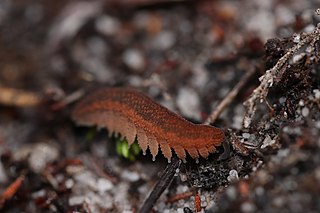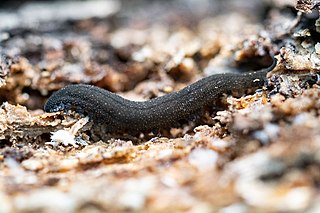Opisthopatus is a genus of South African velvet worms in the family Peripatopsidae. Velvet worms in this genus are found in South Africa, in the Eastern Cape, KwaZulu-Natal, and Mpumalanga provinces, as well as in Lesotho and Eswatini. This genus was first proposed in 1899 by the zoologist William F. Purcell to contain the newly discovered species O. cinctipes, which he designated as the type species.

Peripatopsis is a genus of velvet worms in the Peripatopsidae family. These velvet worms are found in the KwaZulu-Natal, Western Cape, and Eastern Cape provinces of South Africa. This genus was proposed by the British zoologist Reginald I. Pocock in 1894 with Peripatopsis capensis designated as the type species.

Peripatidae is a family of velvet worms. This family includes more than 90 described species distributed among 13 genera, but some authorities deem only 80 of these species to be valid. The oldest putative representatives of the family herald from Burmese amber dated to the mid-Cretaceous, around 100 million years ago, with representatives from Dominican and Baltic amber attesting to a broader distribution in the Palaeogene / Neogene; molecular variability suggests that the family's crown group may have arisen in the early Mesozoic.

Peripatopsidae is one of the two living velvet worm families. This family includes more than 140 described species distributed among 41 genera, but some authorities deem only 131 of these species to be valid. The French zoologist Eugène Louis Bouvier proposed this family in 1905 with Peripatopsis as the type genus.
Metaperipatus is a genus of velvet worms in the family Peripatopsidae that contains two species found in Chile, including Metaperipatus inae. This genus was created by the American zoologist Austin Hobart Clark in 1913 to contain the type species, M. blainvillei. Authorities believe M. blainvillei is a species complex, however, and some consider M. blainvillei a nomen dubium.
Opisthopatus cinctipes is a species of velvet worm in the Peripatopsidae family. This species has 16 pairs of legs, all with claws and all used for walking. The color of the dorsal surface varies from blue to olive green. Females range from 7 mm to 50 mm in length, whereas males range from 6 mm to 36 mm. Like other velvet worms in this genus, this species exhibits matrotrophic viviparity, that is, mothers in this genus retain eggs in their uteri and supply nourishment to their embryos, but without any placenta. The type locality is in South Africa.
Opisthopatus laevis is a species of velvet worm in the Peripatopsidae family. This species has 16 pairs of legs. The type locality is in South Africa. The validity of this species is uncertain: Some authorities consider O. laevis invalid even as a subspecies of O. cinctipes, a similar species also found in South Africa, but other authorities recognize O. laevis as a separate species, citing the significant distance (570 km) between the type localities of these two species.
Peripatopsis balfouri is a species of velvet worm in the Peripatopsidae family. This species has 18 pairs of clawed legs. Also known as the blue velvet worm, this species ranges from 9 mm to 22 mm in length. The type locality is in South Africa.
Peripatopsis birgeri is a species of velvet worm in the family Peripatopsidae. This species is a clade in the P. moseleyi species complex. The number of legs in this species varies from 21 pregenital pairs to 22 pregenital pairs. Live animals are light green, brown, or black with a distinct pale head collar; the ventral surface is creamy white. Males range from 23 mm to 40 mm in length; females range from 28 mm to 40 mm in length. Also known as the Mount Currie velvet worm, this species is known only from the Mount Currie Nature Reserve in South Africa.
Peripatopsis intermedia is a species of velvet worm in the Peripatopsidae family. This species is about 33 mm long and has 19 pairs of legs: 18 pregenital leg pairs plus a last pair of much reduced legs. The type locality is in South Africa. Although some authorities doubt the validity of this species and deem it to be a junior synonym of P. balfouri, others consider these two to be separate species, citing the distance between their type localities.

Peripatopsis lawrencei is a species of velvet worm in the Peripatopsidae family. This species has 17 pairs of legs, with the last pair reduced in size but featuring two claws on each leg. This species is restricted to the Theewaterskloof-Overstrand region of South Africa.

Peripatopsis moseleyi is a species of velvet worm in the Peripatopsidae family. Males of this species have 20 to 24 pairs of legs with claws ; females have 19 to 23 pairs of legs with claws. Females range from 11 mm to 75 mm in length, whereas males range from 9 mm to 50 mm. The type locality is in South Africa.
Peripatopsis sedgwicki is a species of velvet worm in the Peripatopsidae family. Also known as the Tsitsikamma velvet worm, this species has a narrow geographic distribution in South Africa but is especially abundant in the indigenous forest of the Tsitsikamma mountains. Recent phylogenetic analysis using molecular data finds that Peripatopsis sedgwicki as traditionally understood based on morphology is a species complex that contains four different species: P. sedgwicki s.s., P. orientalis, P. collarium, and P. margaritarius.

Peripatopsis overbergiensis, the Overberg velvet worm, is a species of velvet worm in the Peripatopsidae family. This species usually has 19 pairs of legs: 18 pregenital leg pairs plus one last pair that is strongly reduced and without claws or spinous pads. Some individuals, however, have only 18 leg pairs. This species is limited to the Overberg region of South Africa.
Peripatopsis purpureus is a species of velvet worm in the family Peripatopsidae. This species is a clade in the P. balfouri species complex. Males of this species have 17 clawed legs with the last pair highly reduced, whereas females have a complete foot with claws on the reduced leg. Specimens range from 17 mm to 25 mm in length. Named for its purple-blue color, this species is found in the Western Cape Province of South Africa.
Peripatopsis storchi is a species of velvet worm in the family Peripatopsidae. This species is a clade in the P. moseleyi species complex. The number of legs in this species ranges from 21 pregenital pairs to 23 pregenital pairs. Males of this species range from 12 mm to 22 mm in length, and females range from 22 mm to 36 mm in length, but live animals can stretch to 50 mm while walking. Also known as the Katberg velvet worm, this species is known only from the Katberg forest in South Africa.

Peripatopsis alba, the white cave velvet worm, is a species of velvet worm in the family Peripatopsidae. This species is notable as one of only two species of velvet worm known to be troglobitic; the only other velvet worm known to be a troglobiont is Speleoperipatus spelaeus. The white cave velvet worm is rare and limited to one cave system on Table Mountain in South Africa.
Peripatopsis leonina, commonly known as the Lion's Hill velvet worm, is a species of velvet worm in the family Peripatopsidae. Endemic to South Africa, it has not been seen since 1912 and is thought to be critically endangered or possibly extinct.
Opisthopatus herbertorum is a species of velvet worm in the Peripatopsidae family. The type locality is in South Africa. As originally described, this species is uniformly white with 17 pairs of legs. Subsequent phylogenetic results, however, cast doubt on this species delimitation based on morphology, indicating instead that O. herbertorum is a junior synonym of O. roseus.
Peripatopsis aereus is a species of velvet worm in the family Peripatopsidae. This species is known only from the Riviersonderend Mountains in South Africa. This velvet worm was discovered living in sympatry with another species in the same genus, P. lawrencei. These two sympatric species can be distinguished based on the number of legs: The species P. aereus has 18 pairs of legs, whereas the species P. lawrencei has only 17 leg pairs.








